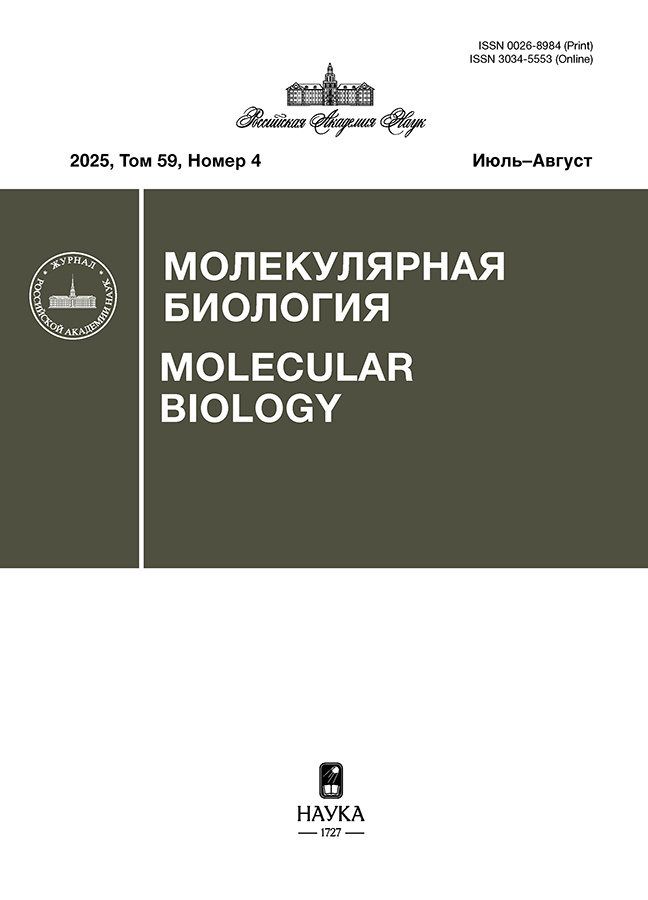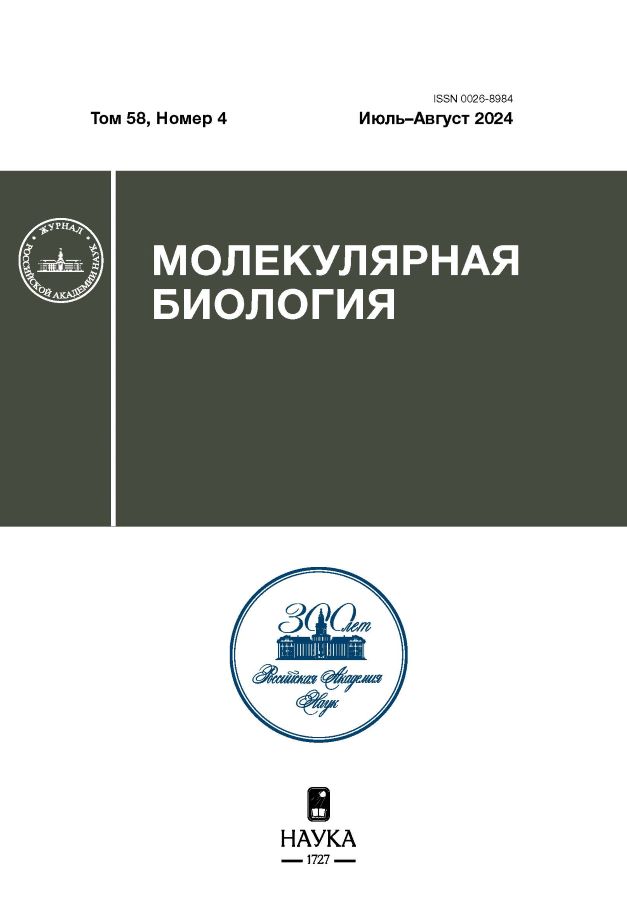Паттерны аминокислотных замен в белках E6 и E7 вируса папилломы человека 16 типа: филогеография и эволюция
- Авторы: Зеленова Е.Е.1,2, Карлсен А.А.3,4, Авдошина Д.В.5, Кюрегян К.К.3,4, Беликова М.Г.3,5,6
-
Учреждения:
- Институт молекулярной биологии им. В. А. Энгельгардта Российской академии наук
- Национальный медицинский исследовательский центр онкологии им. Н. Н. Блохина
- Российский университет дружбы народов
- Институт вакцин и сывороток им. И. И. Мечникова
- Федеральный научный центр исследований и разработки иммунобиологических препаратов им. М. П. Чумакова Российской академии наук
- Научный центр эпидемиологии и микробиологии им. Н. Ф. Гамалеи Министерства здравоохранения Российской Федерации
- Выпуск: Том 58, № 4 (2024)
- Страницы: 549–574
- Раздел: ГЕНОМИКА. ТРАНСКРИПТОМИКА
- URL: https://innoscience.ru/0026-8984/article/view/655301
- DOI: https://doi.org/10.31857/S0026898424040036
- EDN: https://elibrary.ru/INFCZJ
- ID: 655301
Цитировать
Полный текст
Аннотация
Белки E6 и E7 вируса папилломы человека (ВПЧ) играют ключевую роль в онкогенезе папилломавирусной инфекции. Данные по изменчивости этих онкобелков ограничены, а факторы, влияющие на их изменчивость, малоизучены. Нами проанализирована вариабельность известных к настоящему времени последовательностей белков E6 и E7 ВПЧ типа 16 (ВПЧ16) с учетом их географического происхождения и года cбора образцов, а также направления их эволюции в основных географических регионах мира. Из базы данных GenBank NCBI 6 октября 2022 года были выгружены все последовательности, относящиеся к фрагментам генома ВПЧ16, кодирующим онкобелки E6 и E7. Образцы отфильтровали по следующим параметрам: последовательность включает хотя бы одну из двух интересующих рамок считывания целиком, известны дата сбора и страна происхождения. Всего отобрали 3 651 полногеномную нуклеотидную последовательность, кодирующую белок E6, и 4 578 полногеномных нуклеотидных последовательностей, кодирующих белок E7. Полученные после выборки и выравнивания нуклеотидные последовательности переводили в аминокислотные и анализировали с применением программ MEGA11, R, RStudio, Jmodeltest 2.1.20, BEAST v1.10.4, Fastcov и Biostrings. Наибольшая изменчивость первичной структуры белка E6 зарегистрирована в позициях 17, 21, 32, 85 и 90 а. о., а для E7 ‒ в позициях 28, 29, 51 и 77 а. о. Выборка разделилась по географическому признаку на 5 гетерогенных групп: африканскую, европейскую, американскую, регион Юго-Западной и Южной Азии и регион Юго-Восточной Азии. Для ряда стран были выявлены уникальные аминокислотные замены (АК-замены) в белках E6/E7 ВПЧ16, предположительно, характерные для отдельных этнических групп. В основном они локализуются в сайтах известных В- и Т-клеточных эпитопов и относительно редко в структурно-функциональных доменах. Выявленные различия в АК-заменах у различных этнических групп и их колокализация с кластерами B- и T-клеточных эпитопов позволяют предположить их возможную взаимосвязь с географическим распределением аллелей и гаплотипов главного комплекса гистосовместимости (HLA). Это может приводить к распознаванию различного набора В- и Т-клеточных эпитопов вируса, что обусловливает региональные различия в направлении эпитопного дрейфа. В результате филогенетического анализа нуклеотидных последовательностей, кодирующих белок E6 ВПЧ16, выявлен общий предок, подтверждена региональная кластеризация последовательностей гена белка E6 по набору наиболее распространенных АК-замен, а также обнаружены случаи реверсии отдельных АК-замен при изменении региона распространения вируса. Для белка E7 аналогичный анализ был невозможен из-за высокой гомологии последовательностей. Ковариационный анализ совокупной выборки выявил отсутствие взаимосвязи между аминокислотными остатками в белке E6, в белке E7, а также между E6 и E7. Полученные в работе данные важны для разработки терапевтических вакцин против ВПЧ высокого канцерогенного риска.
Полный текст
Об авторах
Е. Е. Зеленова
Институт молекулярной биологии им. В. А. Энгельгардта Российской академии наук; Национальный медицинский исследовательский центр онкологии им. Н. Н. Блохина
Автор, ответственный за переписку.
Email: zelenovayeye@gmail.com
Россия, Москва, 119991; Москва, 115478
А. А. Карлсен
Российский университет дружбы народов; Институт вакцин и сывороток им. И. И. Мечникова
Email: zelenovayeye@gmail.com
Россия, Москва, 117198; Москва, 105064
Д. В. Авдошина
Федеральный научный центр исследований и разработки иммунобиологических препаратов им. М. П. Чумакова Российской академии наук
Email: zelenovayeye@gmail.com
Россия, Москва, 117218
К. К. Кюрегян
Российский университет дружбы народов; Институт вакцин и сывороток им. И. И. Мечникова
Email: zelenovayeye@gmail.com
Россия, Москва, 117198; Москва, 105064
М. Г. Беликова
Российский университет дружбы народов; Федеральный научный центр исследований и разработки иммунобиологических препаратов им. М. П. Чумакова Российской академии наук; Научный центр эпидемиологии и микробиологии им. Н. Ф. Гамалеи Министерства здравоохранения Российской Федерации
Email: zelenovayeye@gmail.com
Россия, Москва, 117198; Москва, 117218; Москва, 123098
Список литературы
- Тихомиров А.Л., Сарсания С.И., Филатова Г.А. (2018) Вирус папилломы человека: от понимания иммунопатогенеза к рациональной тактике ведения. Гинекология. 3, 5–11. doi: 10.26442/2079-5696-2018.3.5-11
- Волгарева Г.М. (2020) Папилломавирусный канцерогенез. Основные достижения и некоторые проблемы Часть 1. Общие представления о папилломавирусах. Формы рака, ассоциированные с вирусами папилломы человека. Российский биотерапевтический журнал. 19(1), 6–12. doi: 10.17650/1726-9784-2019-19-1-6-12
- Huibregtse J.M., Scheffner M., Howley P.M. (1991) A cellular protein mediates association of p53 with the E6 oncoprotein of human papillomavirus types 16 or 18. EMBO J. 10(13), 4129‒4135. doi: 10.1002/j.1460-2075.1991.tb04990.x
- Hebner C., Beglin M., Laimins L.A. (2007) Human papillomavirus E6 proteins mediate resistance to interferon-induced growth arrest through inhibition of p53 acetylation. J. Virol. 81(23), 12740‒12747. doi: 10.1128/JVI.00987-07
- Um S.J., Rhyu J.W., Kim E.J., Jeon K.C., Hwang E.S., Park J.S. (2002) Abrogation of IRF-1 response by high-risk HPV E7 protein in vivo. Cancer Lett. 179(2), 205‒212. doi: 10.1016/s0304-3835(01)00871-0.
- Курмышкина О.В., Волкова Т.О., Ковчур П.И., Бахлаев И.Е., Немова Н.Н. (2011) Гены раннего ответа в патогенезе рака шейки матки: обзор. Опухоли женской репродуктивной системы. 1, 96–105. doi: 10.17650/1994-4098-2011-0-1-96-105
- Duensing A., Spardy N., Chatterjee P., Zheng L., Parry J., Cuevas R., Korzeniewski N., Duensing S. (2009) Centrosome overduplication, chromosomal instability, and human papillomavirus oncoproteins. Environ. Mol. Mutagen. 50(8), 741–747. doi: 10.1002/em.20478
- Ai W., Wu C., Jia L., Xiao X., Xu X., Ren M., Xue T., Zhou X., Wang Y., Gao C. (2022) Deep sequencing of HPV16 E6 region reveals unique mutation pattern of HPV16 and predicts cervical cancer. Microbiol. Spectr. 10(4), e0140122. doi: 10.1128/spectrum.01401-22
- Escobar-Escamilla N., González-Martínez B.E., Araiza-Rodríguez A., Fragoso-Fonseca D.E., Pedroza-Torres A., Landa-Flores M.G., Garcés-Ayala F., Mendieta-Condado E., Díaz-Quiñonez J.A., Castro-Escarpulli G., Ramírez-González J.E. (2019) Mutational landscape and intra-host diversity of human papillomavirus type 16 long control region and E6 variants in cervical samples. Arch. Virol. 164(12), 2953‒2961. doi: 10.1007/s00705-019-04407-6
- Mesplède T., Gagnon D., Bergeron-Labrecque F., Azar I., Sénéchal H., Coutlée F., Archambault J. (2012) p53 degradation activity, expression, and subcellular localization of E6 proteins from 29 human papillomavirus genotypes. J. Virol. 86(1), 94‒107. doi: 10.1128/JVI.00751-11
- Бестаева Н.В., Назарова Н.М., Прилепская В.Н., Трофимов Д.Ю., Бурменская О.В., Суламанидзе Л.А. (2013) Папилломавирусная инфекция: новые взгляды на диагностику и лечение (обзор литературы). Гинекология. 3, 4–7. https://gynecology.orscience.ru/2079-5831/article/view/28190
- Burk R.D., Harari A., Chen Z. (2013) Human papillomavirus genome variants. Virology. 445(1‒2), 232‒243. doi: 10.1016/j.virol.2013.07.018
- Pimenoff V.N., de Oliveira C.M., Bravo I.G. (2017) Transmission between archaic and modern human ancestors during the evolution of the oncogenic human papillomavirus 16. Mol. Biol. Evol. 34(1), 4‒19. doi: 10.1093/molbev/msw214
- Kirnbauer R., Hubbert N.L., Wheeler C.M., Becker T.M., Lowy D.R., Schiller J.T. (1994) A virus-like particle enzyme-linked immunosorbent assay detects serum antibodies in a majority of women infected with human papillomavirus type 16. J. Natl. Cancer Inst. 86(7), 494–499. doi: 10.1093/jnci/86.7.494
- Shally M., Alloul N., Jackman A., Muller M., Gissmann L., Sherman L. (1996) The E6 variant proteins E6I‒E6IV of human papillomavirus 16: expression in cell free systems and bacteria and study of their interaction with p53. Virus Res. 42(1‒2), 81–96. doi: 10.1016/0168-1702(96)01301-9
- Zhao J., Zhu J., Guo J., Zhu T., Zhong J., Liu M., Ruan Y., Liao S., Li F. (2020) Genetic variability and functional implication of HPV16 from cervical intraepithelial neoplasia in Shanghai women. J. Med. Virol. 92(3), 372‒381. doi: 10.1002/jmv.25618
- Ortiz-Ortiz J., Alarcón-Romero L.D.C., Jiménez-López M.A., Garzón-Barrientos V.H., Calleja-Macías I., Barrera-Saldaña H.A., Leyva-Vázquez M.A., Illades-Aguiar B. (2015) Association of human papillomavirus 16 E6 variants with cervical carcinoma and precursor lesions in women from Southern Mexico. Virol. J. 12, 29. doi: 10.1186/s12985-015-0242-3
- Ramas V., Mirazo S., Bonilla S., Ruchansky D., Arbiza J. (2018) Analysis of human papillomavirus 16 E6, E7 genes and long control region in cervical samples from Uruguayan women. Gene. 654, 103‒109. doi: 10.1016/j.gene.2018.02.023
- Szostek S., Zawilinska B., Klimek M., Kosz-Vnenchak M. (2017) HPV16 E6 polymorphism and physical state of viral genome in relation to the risk of cervical cancer in women from the south of Poland. Acta Biochim. Pol. 64(1), 143–149. doi: 10.18388/abp.2016_1364
- Tsakogiannis D., Papadopoulou A., Kontostathi G., Ruether I.G.A., Kyriakopoulou Z., Dimitriou T.G., Orfanoudakis G., Markoulatos P. (2013) Molecular and evolutionary analysis of HPV16 E6 and E7 genes in Greek women. J. Med. Microbiol. 62, 1688‒1696. doi: 10.1099/jmm.0.055491-0
- He H., Li H., Fan P., Zhu J., Pan Z., Pan H., Wu D., Ren X., Guo X., Li D., Pan Z., Shao R. (2016) Variants of human papillomaviruses 16 (HPV16) in Uigur women in Xinjiang, China. Infect. Agent. Cancer. 11, 44. doi: 10.1186/s13027-016-0089-2
- Pan Z., Xu S. (2020) Population genomics of East Asian ethnic groups. Hereditas. 157(1), 49. doi: 10.1186/s41065-020-00162-w
- Hudson M.J., Nakagome S., Whitman J.B. (2020) The evolving Japanese: the dual structure hypothesis at 30. Evol. Hum. Sci. 2, e6.
- doi: 10.1017/ehs.2020.6
- van der Weele P., Meijer C.J.L.M., King A.J. (2017) Whole-genome sequencing and variant analysis of human papillomavirus 16 infections. J. Virol. 91(19), е00844-17. doi: 10.1128/JVI.00844-17
- He J., Li Q., Ma S., Li T., Chen Y., Liu Y., Cui Y., Peng J., Shi Y., Wei X., Ding X. (2022) The polymorphism analysis and epitope predicted of Alphapapillomavirus 9 E6 in Sichuan, China. Virol. J. 19, 14. https:.doi.org/10.1186/s12985-021-01728-4
- Tomaić V. (2016) Functional roles of E6 and E7 oncoproteins in HPV-induced malignancies at diverse anatomical sites. Cancers (Basel). 8, 95. doi.org/10.3390/cancers8100095
- Brauburger K, Hume AJ, Mühlberger E, Olejnik J. (2012) Forty-five years of Marburg virus research. Viruses. 4(10), 1878–927. doi: 10.3390/v4101878
- Kyuregyan K.K., Kichatova V.S., Karlsen A.A., Isaeva O.V., Solonin S.A., Petkov S., Nielsen M., Isaguliants M.G., Mikhailov M.I. (2020) Factors influencing the prevalence of resistance-associated substitutions in NS5A protein in treatment-naive patients with chronic hepatitis C. Biomedicines. 8(4), 80. doi: 10.3390/biomedicines8040080
- Mehta A.M., Mooij M., Branković I., Ouburg S., Morré S.A., Jordanova E.S. (2017) Cervical carcinogenesis and immune response gene polymorphisms: a review. J. Immun. Res. 2017, 8913860. doi: 10.1155/2017/8913860
- Pandey N.O., Chauhan A.V., Raithatha N.S., Patel P.K., Khandelwal R., Desai A.N., Choxi Y., Kapadia R.S., Jain N.D. (2019) Association of TLR4 and TLR9 polymorphisms and haplotypes with cervical cancer susceptibility. Sci. Rep. 9(1), 9729. doi: 10.1038/s41598-019-46077-z
- Tan S.C., Ismail M.P., Duski D.R., Othman N.H., Ankathil R. (2017) FAS c.-671A>G polymorphism and cervical cancer risk: a case-control study and meta-analysis. Cancer Genet. 211, 18–25. doi: 10.1016/j.cancergen.2017.01.004
- Rader J.S., Tsaih S.W., Fullin D., Murray M.W., Iden M., Zimmermann M.T., Flister M.J. (2019) Genetic variations in human papillomavirus and cervical cancer outcomes. Int. J. Cancer. 144(9), 2206–2214. doi: 10.1002/ijc.32038
- Ellis J.R., Keating P.J., Baird J., Hounsell E.F., Renouf D.V., Rowe M., Hopkins D., Duggan-Keen M.F., Bartholomew J.S., Young L.S., Stern P.L. (1995) The association of an HPV16 oncogene variant with HLA-B7 has implications for vaccine design in cervical cancer. Nat. Med. 1(5), 464–470. doi: 10.1038/nm0595-464
- Duvvuri V.R., Duvvuri B., Cuff W.R., Wu G.E., Wu J. (2009) Role of positive selection pressure on the evolution of H5N1 hemagglutinin. Genomics Proteomics Bioinformatics. 7(1‒2), 47–56. doi: 10.1016/S1672-0229(08)60032-7
- Stern A., Andino R. (2016) Viral evolution: it is all about mutations. In: Viral Pathogenesis (3rd edition). Eds Katze M.G., Lynn Law G., Korth M.J., Nathanson N. Elsevier, pp. 233–240. doi: 10.1016/B978-0-12-800964-2.00017-3
- Kumar A., Hussain S., Yadav I.S., Gissmann L., Natarajan K., Das B.C., Bharadwaj M. (2015) Identification of human papillomavirus-16 E6 variation in cervical cancer and their impact on T and B cell epitopes. J. Virol. Methods. 218, 51–58. doi: 10.1016/j.jviromet.2015.03.008
- Kichatova V.S., Kyuregyan K.K., Soboleva N.V., Karlsen A.A., Isaeva O.V., Isaguliants M.G., Mikhailov M.I. (2018) Frequency of interferon-resistance conferring substitutions in amino acid positions 70 and 91 of core protein of the Russian HCV 1b isolates analyzed in the T-cell epitopic context. J. Immunol. Res. 7, 7685371. doi: 10.1155/2018/7685371
- Avila-Rios S., Carlson J.M., John M., Mallal S., Brumme Z.L. (2019) Clinical and evolutionary consequences of HIV adaptation to HLA: implications for vaccine and cure. Curr. Opin. HIV AIDS. 14(3), 194–204. doi: 10.1097/COH.0000000000000541
- Lumley S.F., McNaughton A.L., Klenerman P., Lythgoe K.A., Matthews P.C. (2018) Hepatitis B virus adaptation to the CD8+ T cell response: consequences for host and pathogen. Front. Immunol. 9, 1561. doi: 10.3389/fimmu.2018.01561
Дополнительные файлы























